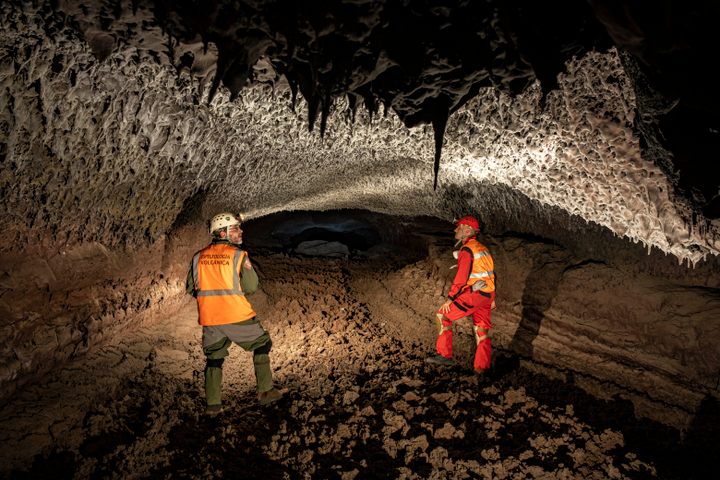
Taking the First Steps Into a Newly Formed Volcanic Underworld
More than a year after a devastating eruption in the Canary Islands, a team is exploring a braided network of still-hot lava tubes.
A cone of light from Octavio Fernández Lorenzo’s headlamp pierces the subterranean darkness. The rocky surfaces that surround him radiate heat, in some places enough to burn unprotected skin. With every step he takes, the temperature rises. But Fernández Lorenzo, vice president of the Canary Federation of Speleology, is not worried about the discomfort. He wants to see a place that no human has seen before.
Not long ago, lava raced through this cave on La Palma, in the Spanish Canary Islands. Over nearly 86 days, starting in September 2021, an eruption pumped some 200 million cubic meters of lava from a fissure near the peak of the Cumbre Vieja ridge. Fresh volcanic rock coated the island’s southwest face, and destroyed thousands of buildings, dozens of miles of road, and almost a thousand acres of farmland. It was the Canary Island’s most destructive eruption in half a millennium.
Winding through this jet-black rock is a vast network of subterranean passages called lava tubes. Like arteries, the tubes carried molten rock away from the beating heart of the eruption. Iceland and other volcanic hotspots around the world have these features, but La Palma represents a fresh opportunity to untangle the complex and lengthy eruption that formed them.

The island’s new underworld has finally cooled enough for Fernández Lorenzo and a team of scientists to take their first steps into the system’s primary branches. The team hopes to create detailed maps and collect samples from these caves to better understand this new landscape and its potential microbial inhabitants. Studying these pioneers is another rare opportunity—a peek into evolution in extreme environments, one that could even provide clues to what life might look like on other worlds.
“It’s an active laboratory,” says geologist Juana Vegas of the Geological and Mining Institute of Spain (IGME), but she stresses that land was also home to hundreds of people who are still stranded by the eruption. Locals are growing impatient as they await decisions about where and when their communities can rebuild, amid debate about protecting parts of the flow for scientific research and as a monument to teach locals and visitors alike about the inner workings of the Earth.
But official construction has already begun, so the team is racing to study the volcanic flow, even as excavators plow routes for new roads. “If these new places are destroyed, they are destroyed forever,” says Nieves Sánchez, lead scientist of IGME’s Canary Island Territorial Unit.
The eruption paved some 4.6 square miles of the island in black. This fresh layer of rock averages a thickness of nearly 50 feet, with some parts reaching a stunning 213 feet. The lava tubes snake through this rock like a braided network of rivers, and Fernández Lorenzo and his team have just started exploration of the outermost branches.
The tubes form as liquid lava flows downhill like an incandescent river. The edges cool first, turning increasingly viscous as they solidify into rock. Next, a crust forms across the top, where the molten rock is exposed to cooler air, like ice growing across the surface of a pond. This blackened crust insulates the lava below, keeping it molten and flowing across long distances. The intense heat from the rush of lava can even start to melt the rock below, deepening the tube. When the eruption stops, the level of lava flowing through the tubes drops until they empty completely, leaving long, snaking caves behind.

But they’re not easily entered. Much of the lava field consists of shifting piles of sharp volcanic rocks the locals call malpaís— “badlands.” Even the smoothest, most-solid-seeming swaths can conceal shallow cavities that could open under a careless step.
“There is a calculated risk,” says Sanchez, who was forced to sit out of recent ventures into the lava tubes after her leg was pinned under a large rock while she was working on another part of the flow. “In our case we were prepared—we have all the protection measures with us—but sometimes accidents [still] occur.”
The effort to study the caves began before the eruption’s end, when swaths of the surface were still too hot to traverse. The scientists used drones to map entrances to subterranean passages, some just slits that researchers have to sidle through. Others are skylights where tube roofs have collapsed.
“It’s exciting when you see these caves that dive off—where does it go?” says David Sanz Mangas, an engineering geologist with IGME who is working with Fernández Lorenzo to study the lava tubes.

Finding answers will take time. As Sanz Mangas explains, the caves likely formed in multiple, stacked layers. The primary arteries are thought to be buried deep underground, and only some of the tubes in the uppermost layer have cooled enough to explore. Of these the team has entered just one that likely connects to the deeper system—the steamy, dark one Fernández Lorenzo and the team were exploring—dubbed the “Red Cave” after its rusty hues.
The Red Cave probably formed when lava overflowed from a larger channel, Fernández Lorenzo says. It has two entrances, which allows air to flow through, speeding the cooling process. But parts of the cave still hover at 140 degrees Fahrenheit, with small safe havens of a balmy 90 to 100 degrees—like standing “inside of an oven,” he says.
Thermal images quickly reveal what lays beyond, a hellish underworld where temperatures soar to several hundred degrees.
The active flow etched its story in the rocky walls of every tube. Reverence fills Fernández Lorenzo’s voice as he describes cave ceilings full of stalactite-like points—drips of frozen lava. Some cavities even have rare spires jutting from the floor, which are created from spatters of dripping lava that build up into cones that can be several feet tall. Some experts call the structures “sandcastles,” because it looks like they were formed from globs of wet sand dropping from a child’s hand. Fernández Lorenzo imitates a splattering sound: “pbbbt.”
As the caves cool and rainwater percolates from above, they begin to sprout—not with plants, but with a variety of delicate, yellow-white mineral formations largely made of compounds of sulfur and salts. When volcanic gases meet cooler air temperatures at the cave entrances, a variety of mineral crusts grow. Some look like geometric crystals while others resemble snowflakes clinging to the rock. As rainwater percolates through cracks, it dissolves some of these minerals, creating new formations of icy-looking stalactites.
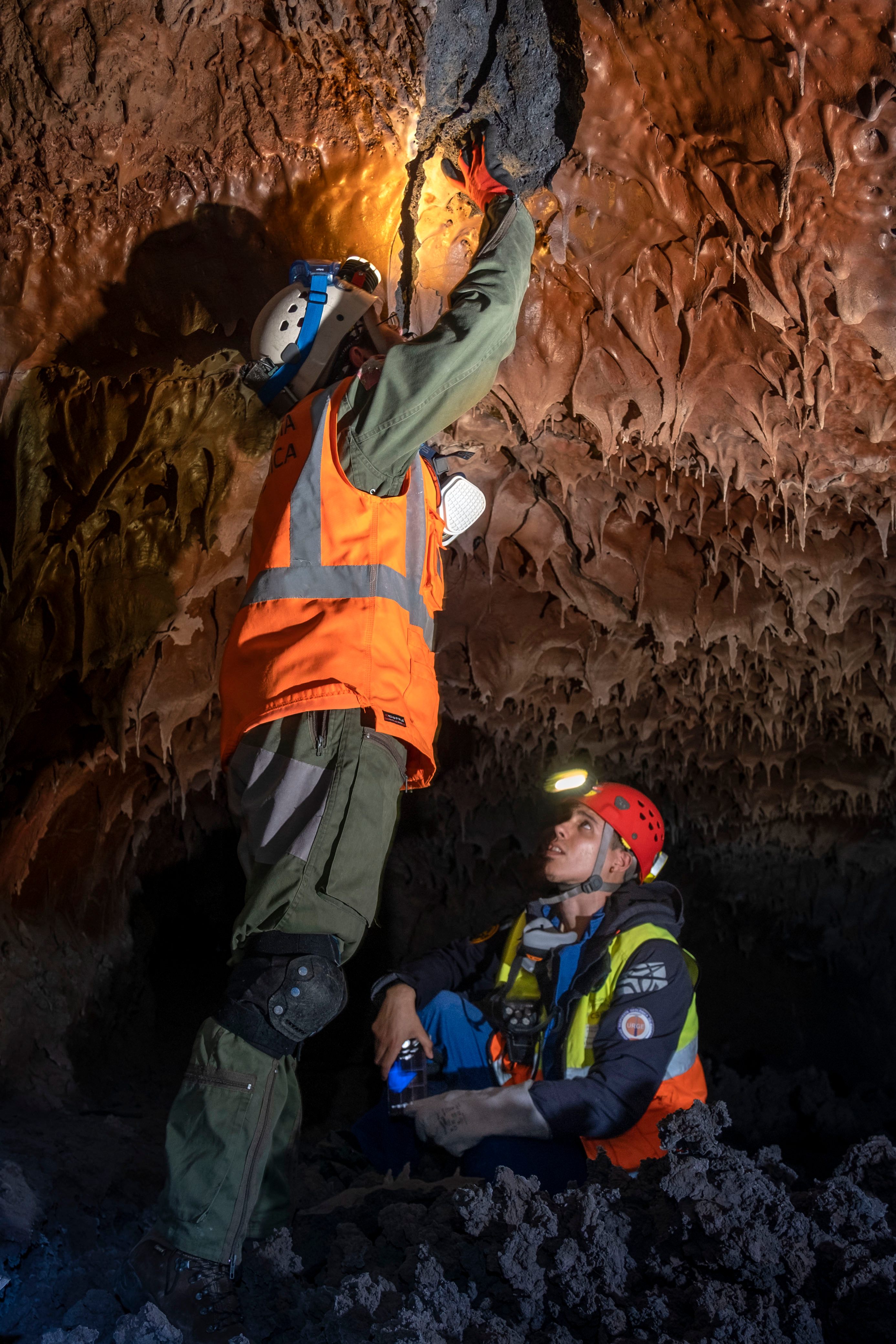
These inverted spires can grow extremely fast, but they may not last, depending on the humidity and temperature. They’re ephemeral, hard to study, and Fernández Lorenzo bemoans the fact he didn’t set up a timelapse camera after he stumbled on a vertical shaft with an entrance full of bright white stalactites. On his next visit, just two months later, some had grown almost eight inches, while others collapsed into powdery white piles.
Hiding among these minerals may be clues to the cave’s first inhabitants. The cooling—but still hot—subterranean world offers a unique habitat for microbes. The team took a series of samples from lava tube walls using a sterile blade and small plastic tubes in hopes of catching the earliest residents, who likely survive by using the rock’s minerals for energy, says Ana Zélia Miller, a microbiologist at the Institute of Natural Resources and Agrobiology of Seville.
There are many reasons to study subterranean life, she says. They might offer useful compounds, such as antibiotics or biocides, or materials, such as minerals used for filtration. The caves also could yield insights about life on other worlds. Both the Moon and Mars have lava tubes, where life could be protected from deadly radiation and meteorite impacts.
No matter what they find, studying La Palma’s lava tubes is a rare chance to watch an evolving ecosystem “from time zero,” Zélia Miller says.
The scientists’ excitement is tempered by the eruption’s disastrous impact. As Sanz Mangas explains, “I am very proud to be there, to be one of the very first people entering this system.” But at the same time, “it’s very hard,” he says. Homes, schools, restaurants, shops, and more now all lie beneath these layers of rock, scorched and crushed.
With excavators now clearing routes for new paths and roads, scientists are increasingly concerned with what might be lost. An excavator recently destroyed a unique section of lava tube before scientists could study it in detail. The tube formed toward the end of the eruption, from a new fissure that opened as part of the volcano’s final gasps.

“They are destroying all these new and unique things,” Vegas says. While it will be necessary to make the new flow navigable, the scientists say, passages can be positioned to preserve as many important volcanic features as possible. In the case of the recently destroyed tube, excavators could have taken a different route, she says. Vegas is leading a team under a special grant from the Canary Island government to map out sites ripe for protection for their potential for science—or as a draw for tourists and local residents.
Studying the flow promises to yield insights into volcanic processes and hazards, an understanding that is vital in the Canaries—an archipelago built by volcanoes. And protecting parts of the flow as a kind of geo-heritage will also allow these sites to stand as powerful reminders of the forces brewing beneath the island.
Despite La Palma’s long history of eruptions, the 2021 event took many by surprise. It was the first time one of the island’s volcanoes had erupted in half a century, long enough for the collective memory to have mostly slipped away. Experts hope this won’t happen again.
“This is an opportunity for the future,” Vegas says.




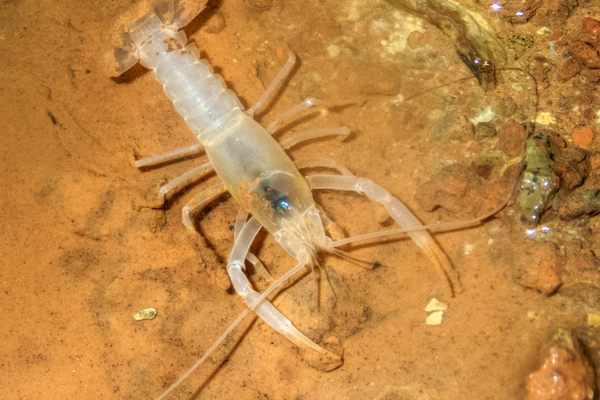
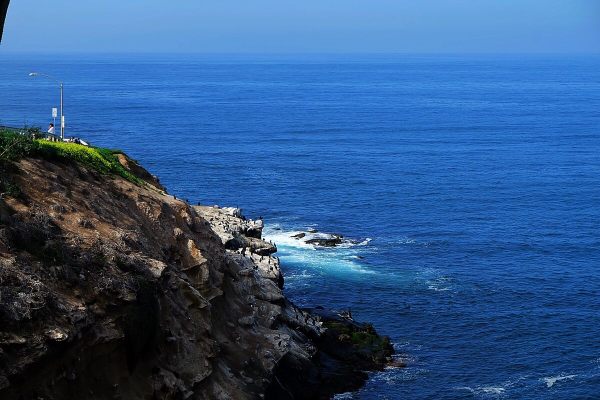
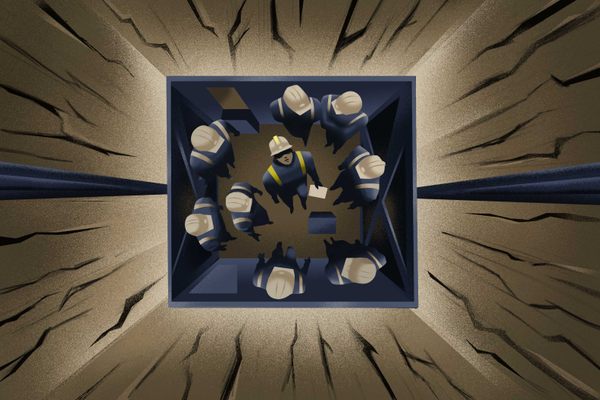
















Follow us on Twitter to get the latest on the world's hidden wonders.
Like us on Facebook to get the latest on the world's hidden wonders.
Follow us on Twitter Like us on Facebook